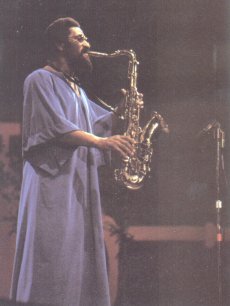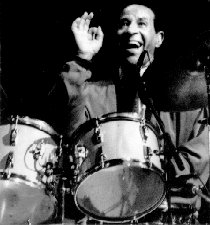LINE-UP:
Sonny Rollins - tenor sax
Tommy Flanagan - piano
Doug Watkins - bass
Max Roach - drums
Recorded in New York City, June 22, 1956. |
|
 LABEL:
LABEL:
PRESTIGE
1. ST. THOMAS
2. YOU DON'T KNOW WHAT LOVE IS
3. STRODE RODE
4. MORITAT
5. BLUE SEVEN
|
A friend told me once Saxophone Colossus was the best album by Rollins
he ever heard. I would say it is definitely one of his best.
One point of strength of this album is its ability to keep you
interested all the time. The songs are all of different character,
there are no long, difficult-to-follow solos, and this makes the
album an easy listening and yet interesting piece of work.
The performers are all well qualified artists,
as you'll probably already know, but here it is obvious they
all speak the same language. This results in an atmosphere that
can best be described as relaxed and inspired.

|
SONNY ROLLINS is a tenor player with a unique sound,
a remarkable rhythmic intuition and melodic vocabulary.
These qualities are obviously heard on Saxophone Colossus.
His solos have clear build-up structures and melodies.
Many consider him to be the greatest living jazz improviser.
He made close to 50 albums as a leader,
recording with legends like Charlie Parker, Lester Young,
Bud Powell, Thelonious Monk, Miles Davis, Coleman Hawkins,
John Coltrane and, on this album, with Max Roach.
Besides Saxophone Colossus (1956), he recorded such classics
as The Bridge (1962), Don't Stop the Carnival (1978) and
Old Flames (1993).
Born in New York City in 1930, Sonny Rollins first studied piano,
but soon set his heart on playing the saxophone.
By the time he was 19, his career had taken off in an enormous way.
His musical influence effected the jazz from the bebop in the 50's
to the so-called avant-garde through the 60's. In the 70's,
Sonny expanded his repertoire with for example pop-based tunes
and tunes that have a funk beat.
Sonny Rollins calls himself "a survivor of jazz's illustrious period".
Being a legend of the past, Rollins also thinks about the future.
"I get a little leeway for being who I am," he says, "but I still
have to be good when people pay their money. It's an okay challenge.
I'm still yearning to get to my peak, and I haven't reached that
point yet." |
MAX ROACH is not just a great composer,
educator and musician. He made historic moments in music happen.
In the 40's he experimented with Dizzy Gillespie, Charlie Parker,
Oscar Pettiford, Coleman Hawkins and Thelonious Monk.
He got his first job in 1942, when he was called to sub
for Sonny Greer with the great Duke Ellington Orchestra
at New York's Paramount Theatre. He was 18 at the time.
Max Roach is, more than anyone else, responsible for
the transformation of the role of the drummer from keeper of
the beat to leader of the band. On Saxophone Colossus you can
hear his controlled style and ability to make complex rhythms
sound logical. He made clear that the drumset is viable as a solo
instrument.
He sees the American drum set as symbolic of our cultural diversity.
The cymbals are from the Middle East; the side drums simulate
the drums of Africa and of native America; and the snare and
bass drums come from a World Music tradition. "The trap drum set
is a complete percussion ensemble" Max says, "to master
the instrument one must learn to use both hands and feet
independently to create layers of rhythmic
patterns at the same time." |

|
"Max Roach is the Duke Ellington of the Drums.
More than any other percussionist in American music,
Max Roach elevated the trap kit and cymbals
to orchestral dimensions."
- International Musicians and Recording World Magazine
"To call Max Roach a jazz drummer is like calling Shakespeare
a strolling player."
- Anna Kisselgoff, New York Times
TOMMY FLANAGAN and DOUG WATKINS are the piano-
and bassplayers, respectively, on this album. They play a solid
base for the music. Their solos are good, though less interesting
than the ones by the artists spoken of above.
In short, Saxophone Colossus is a fantastic album, that stays
interesting all through. Go buy it and hear for yourself!
|
 LABEL:
LABEL:
